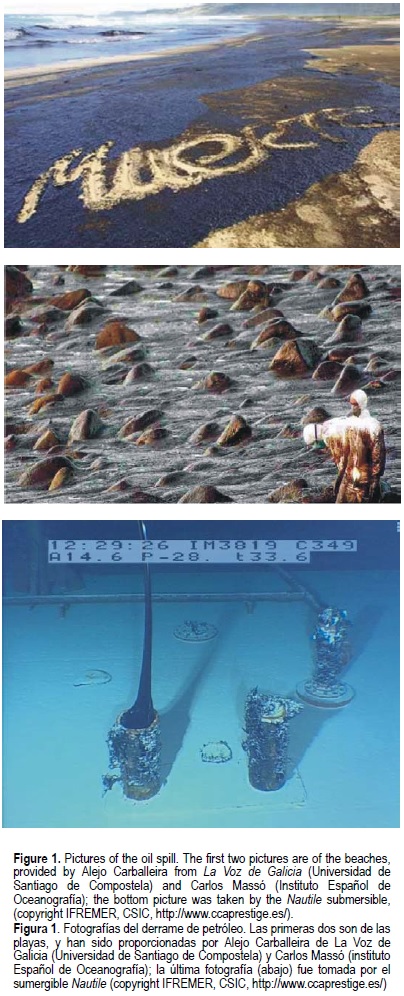Serviços Personalizados
Journal
Artigo
Indicadores
-
 Citado por SciELO
Citado por SciELO -
 Acessos
Acessos
Links relacionados
-
 Similares em
SciELO
Similares em
SciELO
Compartilhar
Ciencias marinas
versão impressa ISSN 0185-3880
Cienc. mar vol.29 no.1 Ensenada Mar. 2003
Nota del editor
The oil spill produced by the tanker Prestige (13/11/2002): Impact assessment of the northwest coast of the Iberian Peninsula
El vertido producido por el petrolero Prestige (13/11/2002): Evaluación del impacto sufrido en la costa noroeste de la Península Ibérica
Ángel DelValls*
* Coordinator of the Spanish Group of UNESCO-Chairs in Environment Department of Physical-Chemistry, Faculty of Marine and Environmental Sciences University of Cádiz Puerto Real, Cádiz, Spain.
16th January, 2003
On 13 November 2002, at about 14:15 hours, the approximately 26-year-old tanker named Prestige sent an SOS to the Spanish authorities responsible for maritime security and safety in the area; it was the beginning of the nightmare associated with the latest ecological tragedy from a long list of tanker accidents off the Galician coasts (northwestern Iberian Peninsula). Nobody could imagine that two months after the spill the amount of oil originated by the shipwreck would be about 30,000 tons. To date, more than 18,000 tons have been collected directly from the sea and about 40,000 tons from the coast (beaches, etc.; see photograph on the cover of this issue). The Spanish Society of Ornithology reported that the Prestige oil spill is the worst episode of sea bird mortality suffered by Spain, and the second in Europe after the oil spill from the tanker Erika in December 1999. Until 16 January 2003, a total of 13,221 birds of 62 different species have been collected from the Spanish, Portuguese and French coasts, of which 3,873 were alive and 9,348 were dead (Carballeira, pers. comm.). Nevertheless, the worst of the oil spill may yet arrive, since more than 50,000 tons of oil are still on the tanker that has sunk to a depth of more than 3500 m (fig. 1).

The physicochemical characteristics of the oil spilled by the tanker Prestige show that the soluble fraction is low and the kinetic of degradation is slow under natural conditions. The spill is characterized by dispersion in different aliquots that has affected a large coastal area of the northwestern Iberian Peninsula (about 1000 km of the Galician coast), which could be persistent based on the continuous spill of oil from the sunken tanker. Under these conditions, the acute impact produced by the direct spill of the oil on beaches and other coastal ecosystems can be predicted to continue affecting the rest of the ecosystem.
The high heterogeneity of the habitats located along the northwest coast of the Iberian Peninsula, both around Galicia and Portugal, alternates rocky coast with a high hydrodynamic regimen, large and small sandy beaches, muddy salt marshes, dune systems, lagoons, etc. This makes it more complex to determine the impact of the spill on the pristine environmental quality of these areas and to design a correct and useful monitoring system, because the biological effects associated with the chemicals from the oil spill will be dependent on the nature of the ecosystem that accepts them and the organisms living in it.
The following research notes report the first results of the early impact produced by the oil spill on the ecosystems along the northwest coast of the Iberian Peninsula, obtained through different kinds of approaches and by different groups of researchers, both Spanish (Galician) and Portuguese. I would like to thank all the authors for their efforts and enthusiastic work to produce these papers in such a short period of time (a month and a half since the last week in November). They undertook the work without any extra funds from this journal or from this author, who invited them to participate in this endeavor. These research notes do not attempt to evaluate the political and/or economical implications of the accident; they just present the readers with the real impact of the spill on the marine ecosystems, different than the visible oil impact on the coast (fig. 1).
The first research note deals with chemical implications of the oil spill, regarding its tracers (Prego and Cobelo, Instituto de Investigaciones Marinas de Vigo, CSIC). The assessment of the levels of hydrocarbons from the oil spill in different organisms on the Portuguese coast was developed by Ferreira et al. (Instituto de Investigação Agrária e das Pescas/IPIMAR) and discussed in the third research note. To determine the toxicity of the oil products and intermediates in both the pelagic and benthic ecosystems, different toxicity tests were carried out on sediments and seawater collected in impacted and non-impacted areas from the Galician coast and evaluated by Mariño-Balsa et al. (Universidad de Vigo). As a final overview of the problem, Alejo Carballeira (Universidad de Santiago de Compostela) discusses and proposes an integrative assessment for monitoring the impact of the oil spill, not only during these first months of the catastrophe but also for the next few years, taking into account the persistence of the effects associated with the spill.
Finally, I would like to thank the University of Cádiz for supporting this initiative and the editorial work of the journal Ciencias Marinas in Europe, as well as the editorial team (Manuel, Raúl, Shelly, Christine and Miriam) at the central office in Ensenada, Mexico. This initiative is under the regular activities of the UNITWIN/UNESCO/Chairs network: Wise Coastal Practices for Sustainable Human Development, regional Europe (WiCoP-Europe).
Note from the Associated Editor in Europe.














